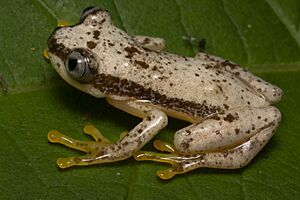Afrixalus uluguruensis facts for kids
Quick facts for kids Afrixalus uluguruensis |
|
|---|---|
 |
|
| Conservation status | |
| Scientific classification | |
| Synonyms | |
|
Megalixalus uluguruensis Barbour and Loveridge, 1928 |
The Afrixalus uluguruensis is a small frog known as the Uluguru banana frog. It belongs to the Hyperoliidae family. This frog lives only in the Eastern Arc Mountains of Tanzania. You can find it in places like the Uluguru Mountains and Udzungwa Mountains.
About Its Name
The scientific name, uluguruensis, comes from the Uluguru Mountains. This is where the first frog of this kind was discovered.
What It Looks Like
This frog is quite small. Male frogs are about 23 to 25.5 millimeters long. Females are a bit bigger, measuring 24 to 28 millimeters. That's about the size of a large paperclip!
The Uluguru banana frog has a wide head. Its back is white with dark, uneven spots. These spots usually don't form a clear pattern. Male frogs have tiny, spiky bumps on their back, head, and legs. Female frogs have smooth skin. Their front feet are partly webbed, and their back feet are fully webbed. This helps them move around.
Where It Lives and How We Protect It
The Uluguru banana frog lives in tropical forests. It prefers areas between 600 and 2200 meters above sea level. These frogs like to breed in slow-moving streams and swampy areas. They also use temporary pools found in thick forests. Some of the first frogs found were living on wild banana plants in a rainforest. They mostly eat insects, like beetles.
There are many of these frogs in the places where they live. However, they cannot survive if their home is damaged. Their habitat is shrinking because of farming, logging, and new human settlements. Luckily, this frog lives in several protected areas. These include the Uluguru Nature Reserve and Udzungwa Mountains National Park. These parks help keep their forest homes safe.


